|
|||||
FlyingRC.net is a
Veteran-Owned site.

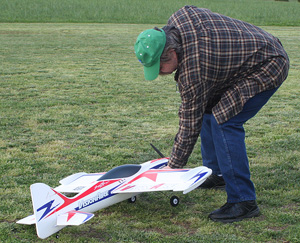 |
The Visionaire was my first plane upon returning to RC Flying after a 25 year absence. It (and I) survived and I got right back into the swing of things. Click image to enlarge |
VisionAire 3D “Foamy” RC Airplane
Easy-flying mayhem in the sky
Text, photos and video by Tom Hintz
Posted – 4-27-2013
When I decided to get back into flying radio controlled (RC) airplanes I was sure that it would not take me real long to reacquaint myself with normal flight so I needed a plane that could function as a trainer with the controls tamed down but could handle more aerobatic flying later. I already had a Spektrum DX6I 6-channel radio bought during my largely aborted helicopter days so I began looking for a compatible aircraft.
The VisionAire (by ParkZone) quickly rose to the top of that list for a number of reasons. I had discovered the wonder of the “Bind and Fly” RC world where you buy a plane already equipped with the servos and receiver and you simply bind that system to your transmitter. Of course they have to be compatible but the VisionAire carries Spektrum™ equipment that matches my transmitter.
The deciding factor in my decision to get a VisionAire was that it is electric powered. I would have simply turned my nose up at electric aircraft 25 years ago. However after a trip to the local flying field where I witnessed todays electric planes in action I realized that as with the radios, electric flight had come a long, long way. I watched several videos of the VisionAire in flight and though I understood that I was probably watching the best pilots in the world flying it, the performance was remarkable. That cinched it.
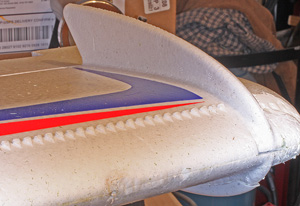 |
 |
The wing is about 2"-thick (left) and has rows of triangular-shaped vortex generators along the top and bottom of the wing. You can also see the fins that help keep the air moving over, not off of the wing. The wings are mounted over a large carbon fiber (right) spar. A single screw locks them in place so they can be removed for travel if necessary. Click images to enlarge |
|
The Basics
The VisionAire has a wingspan of 45” (1143mm) and is 42.5” (1088mm) long which means that my 60-something eyes could see it in the sky. It is made from a special Carbon-reinforced Z-Foam™ that gives it a remarkably light flying weight (all components installed) of only 43.7-oz (1240 g). That combined with the wing area of 539-sq in (34.8 sq. dm) should mean that the VisionAire will remain controllable at rather slow speeds.
The wing is slightly over 2” thick so it generates lots of lift. It also sports rows of specially-shaped bumps along the top and bottom called leading-edge vortex generators. Their purpose is to tweak the airflow so that it stays in contact with the wing (laminar flow) to enhance lift and control. They may look a little weird but they do seem to work.
Another standout feature is the vertical “fins” along the top and bottom of the wings near the ends. Those fins help keep the airflow going straight over the wing rather than bleeding off the tip. That helps the wing to make lift at much slower speeds. That additional airflow also keeps the ailerons functional at surprisingly low speeds as well. Both of those capabilities are helpful for new hobbyists as well as experienced pilots doing the remarkable low-speed 3D aerobatics. I had used similar “end plates” on my favorite plane 25 years ago and learned to love them.
The control surfaces are mounted on double-beveled hinges that allow for the large throws that make the VisionAire so maneuverable. The landing gear is made of durable wire with large wheels for flying off grass. I have had some hard landings that distorted the gear but I just bend them back into shape and go back to flying. I know some think the gear wire bends too easily but I think it is a good shock absorber that prevents damaging the fuselage.
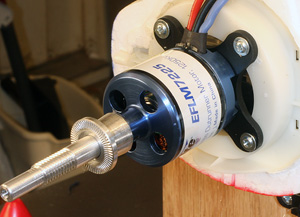 |
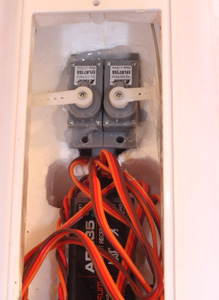 |
A strong brushless motor (left) is installed and wired at the factory. The servos and radio gear (right) are also fully installed right out of the box. Click images to enlarge |
|
Power comes from a 10-size BL10 brushless outrunner electric motor, 1250Kv that is installed at the factory. That motor swings a 12 X 4 (12”-diameter, 4 pitch) propeller with authority. The motor is controlled by an E-flite® 40-amp Lite Pro Switch-Mode BEC brushless speed controller that is also factory installed. The VisionAire uses an E-flite® 11.1V 3S 2200mAh 25C Li-Po high tech battery, one of which is included.
The air born radio gear consists of a Spektrum AR635 6-channel DSMX® AS3X® sport receiver and four E-flite® 13 g digital high-speed servos (Spektrum) that are also factory installed and adjusted. The radio gear is powered off the same battery as the motor so all that stands between you and flying is charging the battery (they do include a simple charger) and binding the radio, the process which matches your transmitter (bought separately) to that plane. I also had to follow the settings listed in the manual for setting up my Spektrum™ DX6i for the VisionAire.
AS3X System
The AR635 receiver has something called AS3X built into it. This is a kind stabilization system that helps the pilot keep the VisionAire under control, sort of. Some consider this AS3X to be a type of autopilot but that is not true, this system does not fly the plane for you, it just tries to maintain the attitude you just told the plane to assume.
The AS3X system is most effective with the controls at full throw so it is not a good “crutch” for beginning pilots. The system does function at low rates but its corrections are minimal. Even at full throw you have to be flying the VisionAire with the appropriate commands to let the AS3X smooth things out for you. When you get to where you are proficient at 3D flying the AS3X system really shines.
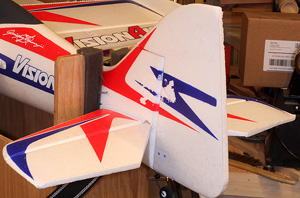 |
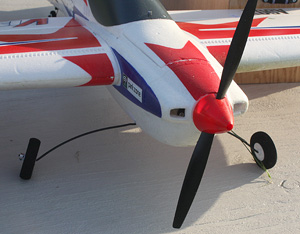 |
All of the control surfaces on the VisionAire (left) are generous to say the least. This is where dual rates tames the animal for the beginner, for now. The wire landing gear (right provides some shock absorption when the pilot goes brain dead on short final and hastens the meeting with the ground. I bent this back to its original shape and went back flying! Click images to enlarge |
|
In the Air
Flying the VisionAire turned out to be easy if I kept it on the low rates at least initially. I still like the low rates for takeoff and landing – except when the wind is gusty. In the turbulence of gusty winds leaving the VisionAire on high rates lets the AS3X help smooth the plane out on the final approach.
The VisionAire is so docile in low rates that it really can be a first low wing trainer or the stepping stone from general sport planes to 3D capabilities. The low speed characteristics of the VisionAire are remarkable. The thick, wide wing and low overall weight makes the VisionAire easy to fly and predictable at slower speeds. In fact, the VisionAire does not like to go too fast. This plane really is designed for the low speed aerobatics of 3D flying where the AS3X system can shine. Take that same stabilization up to speed and it tends to hunt or oscillate the control surfaces.
Don’t let the lower speed envelope fool you; this is a fun to fly, fully aerobatic plane that is capable of loops, rolls, knife-edge flight along with the full batch of 3D maneuvers. The fact that the VisionAire does all this at slower speeds makes it easier for the novice to learn aerobatics and move into 3D.
Another interesting characteristic of the VisionAire is the durability of the foam from which it is made. On the first day I flew the VisionAire (also the first time I had flown anything in 25 years) I made a classic rookie mistake and went way too far out for the final turn into the field and “landed” the VisionAire 75-feet up in a big tree. Though I expected the worst, when I got to the tree the VisionAire looked OK. Later when the bucket truck was summoned to get my and another fellows plane (he hit the tree the day before on the other side, about 80-feet up) down I was amazed at the lack of damage.
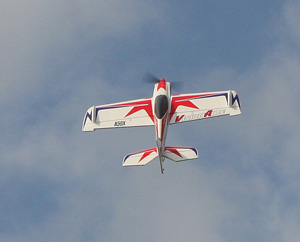 |
 |
I am a total beginner with 3D (left) considering I have about a month under my belt since the 25 year layoff but the VisionAire does make hovers easier though not a sure thing by any means. I am still able to bring it down low (right) inverted because the VisionAire is so stable. You can see me do a tail touch inverted in the video below and it flew away! Click images to enlarge |
|
Both wing tips had impacted branches at around half throttle and both were dented, one showing an actual break in the foam surface. While you can buy individual wings and other parts (HorizonHobby.com actually has them in stock) at very reasonable prices I opted to try fixing my own. I used a couple globs of regular home lightweight spackling compound that was smoothed into the damage and later sanded the surface sort of smooth. I really didn’t put much effort into making it pretty because I couldn’t imagine the patches staying put. But, many snap rolls later – and one wing-tip, nose, wing-tip cartwheel later the patches are still there and look just as they did after sanding, except for a little grass stain on one of them. This is the kind of durability and ease of repair I wish I had 30 years ago when I started flying!
Conclusions
The VisionAire is an exceptionally easy plane to fly yet is capable of all of the jaw-dropping 3D maneuvers you can imagine. Though probably not the best choice for a first plane the VisionAire could very well represent the fast track to low wing aerobatics for graduates of a high wing trainer. The low-speed handling along with tremendous lift contributes to its compatibility with a wide range of pilot experience levels. For the experienced 3D pilot the VisionAire has the capabilities you need to amaze the people at your flying field.
I love the idea of being able to buy individual parts to replace anything on the VisionAire especially since the parts are most often in stock and very reasonably priced. The Bind-N-Fly version of the VisionAire shown here cost me $299.99 (3-12-2013) which includes the trick receiver, servos, speed control, motor and a battery. All of the electronics are factory installed leaving me to assemble the wings and horizontal stabilizers to the fuselage which took about half an hour.
Video Tour |
|
If you are looking for your next plane and have 3D aspirations the VisionAire should be on your short list of must-see’s. This is a fun plane with lots of capabilities even if you are not a highly skilled veteran pilot. The fact that you can get the Bind-N-Fly version so cheaply makes it just that much nicer.
Click Here to see the Product Page
Have a comment on this review? –Email Me!
All Flyingrc.net written, photographic and drawn materials are property of and copyright by Tom Hintz and Flyingrc.net 2013-2020 Materials cannot be used in any way without the prior written permission of the owner.
Privacy Statement


